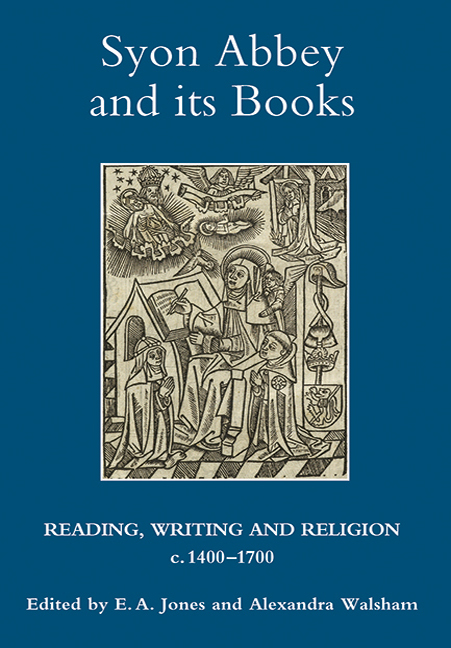Book contents
- Frontmatter
- Contents
- List of Illustrations
- Acknowledgments
- Notes on Contributors
- List of Abbreviations
- Syon Abbey: An Outline Chronology
- Introduction: Syon Abbey and its Books: Origins, Influences and Transitions
- I Brothers and Sisters
- II Syon Abbey and the Book Trade
- III The Bridgettines in Exile
- IV History and Memory
- Appendix Syon Abbey's Books at the University of Exeter
- Index
- Miscellaneous Endmatter
Introduction: Syon Abbey and its Books: Origins, Influences and Transitions
Published online by Cambridge University Press: 09 May 2017
- Frontmatter
- Contents
- List of Illustrations
- Acknowledgments
- Notes on Contributors
- List of Abbreviations
- Syon Abbey: An Outline Chronology
- Introduction: Syon Abbey and its Books: Origins, Influences and Transitions
- I Brothers and Sisters
- II Syon Abbey and the Book Trade
- III The Bridgettines in Exile
- IV History and Memory
- Appendix Syon Abbey's Books at the University of Exeter
- Index
- Miscellaneous Endmatter
Summary
Remembrynge þat god is there present and seeth what ye do Lete none see you from the seruyce of god or vnoccupyed. In redynge of prophetes epystles, gospelles, sayntes lyues, & other dedes of vertue doynge, hauynge euer bokes in your handes, studyenge or wrytynge, þat people seynge you may saye. Beholde here the seruaunt of god, & the lanternes of the worlde.
So wrote Thomas Betson, deacon, librarian and author of Syon Abbey in his Ryght Profytable Treatyse published by Wynkyn de Worde in 1500. A devotional compilation incorporating basic catechetical material alongside supplications and exhortations to the cloistered sisters of the Bridgettine house he served, Betson's advice was taken to heart by a long succession of nuns of this contemplative order, as well as by a wider constituency of devout lay people who sought to mimic their piety. Reading and prayer were intricately linked in the religious lives of the women and men who entered this double monastery in the pre-Reformation period. Books remained central to the community during its travails in exile after the dissolution of the monasteries and the Protestant Reformation, as the library they lovingly preserved and carried back with them to England in the nineteenth century reveals. Among its many treasures is a tiny worn leather-bound book filled with meditations for each day of the week written by the Tridentine archbishop of Milan, Charles Borromeo, together with The contract and testament of the soule (1638) which he invited each Christian to enter into for his or her spiritual health. The Syon copy is a poignant living artefact, bearing the signature of a certain Sister Mary, and incorporating, in the blank pages bound at the end, a series of three handwritten ‘Exercises or Prayers to be devoutly said before the most Blessed Sacrament for the continual performance of your three most solemn Vows’ of poverty, obedience and chastity, together with a further supplication in French. It allows us an intimate glimpse of an expatriate community whose adversities were tempered by an earnest conviction that God would eventually restore Catholicism in their native land.
- Type
- Chapter
- Information
- Syon Abbey and its BooksReading, Writing and Religion, c.1400-1700, pp. 1 - 38Publisher: Boydell & BrewerPrint publication year: 2010

